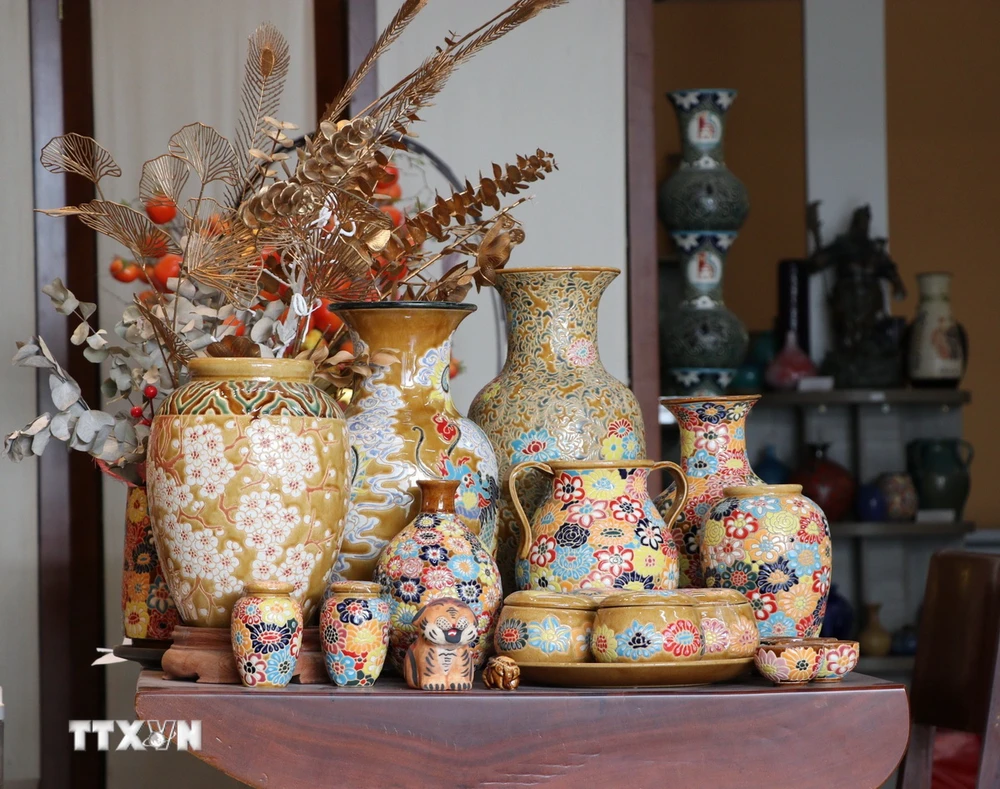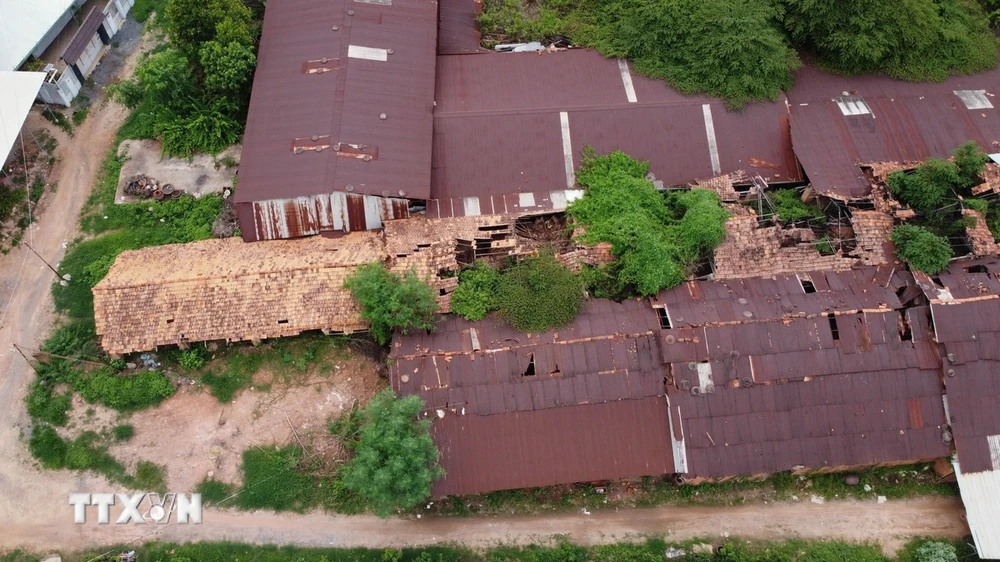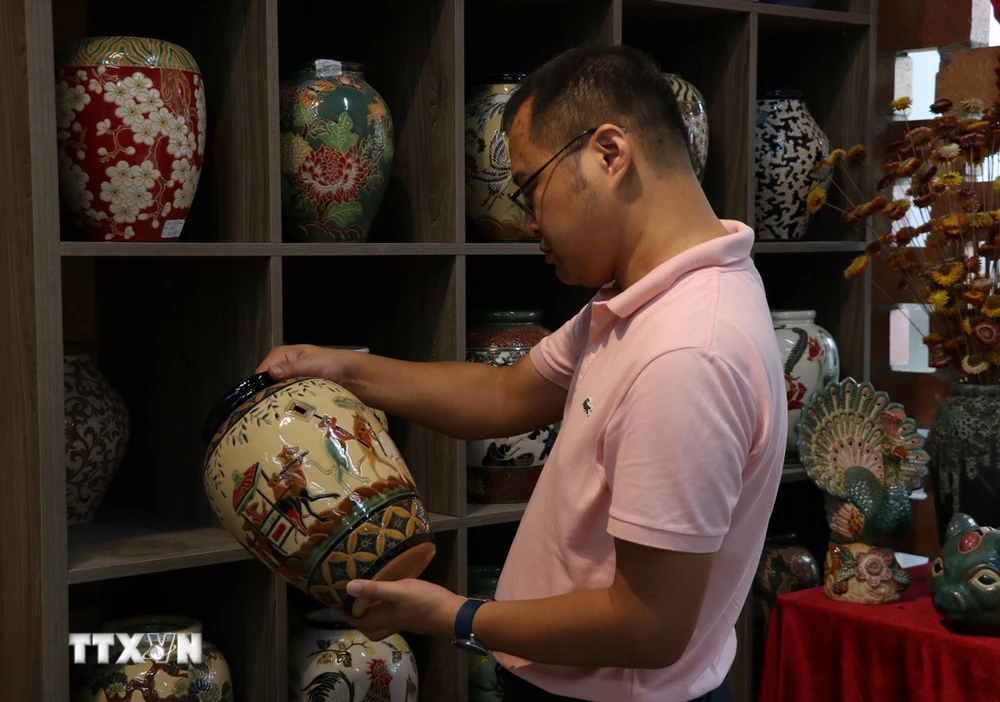
With more than 300 years of accompanying the history of formation and development of Bien Hoa land, Dong Nai province, Bien Hoa traditional pottery has affirmed its own unique features that no other pottery village has.
According to researchers, Bien Hoa ceramics is the only Vietnamese ceramic brand recognized internationally for its distinctive glaze material, “flowering bronze green glaze.”
The sophisticated features and unique glaze that artisans breathe into each product have helped Bien Hoa pottery be welcomed by pottery lovers at home and abroad.
Five generations preserve 200-year-old pottery kiln
Along both banks of the poetic Dong Nai River, Bien Hoa pottery village with dozens of production facilities, stretches from Vinh Cuu district downstream to Bien Hoa city; mainly concentrated in Tan Hanh, Hoa An, Buu Hoa, Tan Van, Hiep Hoa wards (also known as Cu Lao Pho) of this city.
Located opposite Cu Lao Pho (a once bustling trading port) on the other side of the Dong Nai River is the ancient Phong Son pottery kiln, built around the end of the 19th century, nearly 200 years ago. Although many items have rotted over time, the kiln roof is full of holes, and vines cover the chimney, the main body of the ancient Phong Son pottery kiln is still intact.
“Our generation is the 5th generation of our family to keep the pottery kiln that our ancestors left almost intact. We are determined to preserve it so that the current and future generations can know the history and tradition of Bien Hoa pottery,” said Mai Ngoc Nhi, the 5th generation artisan of Phong Son pottery kiln, Bien Hoa, Dong Nai.
According to Ms. Nhi, every day Phong Son ancient pottery kiln is still open to welcome delegations of students, experts, and researchers from home and abroad to visit, learn and exchange academic knowledge about Bien Hoa ancient pottery.
Ms. Mai Ngoc Nhi said that the ceramic lines that made Bien Hoa ceramics famous are black clay ceramics and fine art ceramics. The main materials for producing Bien Hoa ceramics are clay and kaolin. Of which, black clay ceramics are fired in traditional kilns, using firewood. The firing stage is considered the most important step that determines the success or failure of a batch of ceramics. Each batch of ceramics is usually fired for about 10 days at a temperature of 1,200 degrees Celsius.

Ms. Mai Ngoc Nhi said that with its long history, Bien Hoa pottery has affirmed its name in the world market. Bien Hoa pottery products have been exported to many countries around the world, and are very popular in markets such as Japan, Korea, Europe, and the US.
Pottery artisan Nguyen Thanh Phi (Phong Son pottery kiln) said that the steps to create a ceramic product are beating the clay, shaping, glazing, patterning and firing the ceramic. “Each step has its own techniques and dexterity. At the pottery kilns, each person usually does one step. The work requires meticulousness and concentration. To have a beautiful product, the craftsman must devote his heart and attention, putting his feelings into the product,” artisan Nguyen Thanh Phi shared.
"Green enamel blooming" characteristic
Professor-PhD Phan Thi Thu Hien, University of Social Sciences and Humanities, Ho Chi Minh City National University, said that Bien Hoa pottery has a tradition of more than 300 years, as old as the history of Bien Hoa city. The value that Bien Hoa pottery left behind not only includes tangible heritages such as household items, fine art products, or architectural works..., but also the only Vietnamese pottery brand to be recognized internationally, with the characteristic glaze material "green blooming copper glaze" (vert de Bien Hoa).
According to experts researching Bien Hoa pottery, to get the blooming bronze green glaze color, initially artisans used clay from Song Be region, An Giang white stone, Can Long lime, along with straw ash, wood ash, rice husk ash, glass, copper shavings, and pigments to create the unique color of Bien Hoa pottery.
In addition to the blooming bronze glaze, Bien Hoa pottery is also famous for its laterite red glaze. Laterite is excavated at a certain depth, the typical laterite of this region contains 25% iron oxide, so when mixed with color, the laterite has a slightly dark red color. Red stone mixed with white glaze will produce brown, dark red, or earthy yellow depending on the mixing ratio between stone and glaze.
According to research, the pottery profession appeared in Bien Hoa around the 17th century, when Vietnamese and Chinese immigrants came to reclaim the land of Dong Nai. Among the group were potters, who later established pottery kilns in Cu Lao Pho.
From the late 19th century to the 20th century, the pottery industry developed strongly and was considered the most prosperous period of Bien Hoa pottery. Some researchers believe that Bien Hoa pottery products are popular, in addition to the above factors, there is also the intersection between 3 pottery lines of Vietnamese, Chinese and Cham people. This is also the unique feature of cultural intersection that few pottery lines have.
Attracting young people to pottery to preserve the profession
“The most worrying thing about preserving the traditional pottery craft in Bien Hoa today is the people. Pottery artisans are becoming increasingly scarce. The elderly who have been involved for decades are now in poor health. Meanwhile, young people today find pottery making hard work, so few people learn the craft.
The wish of potters like us today is to make young people love pottery more, come to pottery and follow the pottery profession, and join hands to preserve the traditional craft that our ancestors have passed down for more than 300 years to this Bien Hoa land," said Ms. Mai Ngoc Nhi.

As a long-time potter, more than anyone else, those who have been inspired by the profession like Ms. Nhi are struggling to bring young people closer to pottery. Ms. Nhi said that Phong Son pottery kiln has opened workshops on pottery and organized practical experiences at the kilns to bring young people closer to this profession.
“By participating in the experience, they will learn, love more, gradually become attached, and try to keep the fire of pottery from cooling down,” Nhi hopes, adding that the good news is that recently, many young people have participated, and some of them have opened their own pottery showrooms in Ho Chi Minh City and neighboring provinces and cities.
Artisan Le Thanh Nhan (who has been involved in the pottery profession for over 30 years in Tan Van, Bien Hoa), expressed his concern about the gradual decline of the pottery profession. “Young people today are not very interested in pottery, unlike our generation in the past. Our children and grandchildren do not study pottery anymore because they find it too hard,” Mr. Nhan confided.
At a recent workshop on the conservation and development of Bien Hoa pottery, Professor-Doctor Phan Thi Thu Hien said that the journey of Bien Hoa pottery goes along with the history of Dong Nai in particular, and the Southeast in general, always in the pioneering position, from the early days of opening the land, through the resistance wars against France and America, and then to the cause of nation building.
Ceramics in architecture, sculpture, and decoration have made an important contribution to the historical value, artistic value, and cultural value of many historical relics and typical works of Bien Hoa.
Professor-Doctor Phan Thi Thu Hien believes that to preserve and develop the pottery profession, Bien Hoa should be associated with the development of cultural industry, creative industry, and creative city.
“Bien Hoa has all the technological, artistic and business elements to build a ceramic city like many countries in the world, including the model of Jingdezhen city in China, Icheon city in Korea…,” Ms. Hien proposed.
Mr. Nguyen Xuan Thanh, Vice Chairman of Bien Hoa City People's Committee, said that the pottery craft is considered one of the "treasures" of Bien Hoa that needs to be preserved and conserved, in order to promote and spread its unique values. One of the ways to honor and enhance the use value and symbolic value of Bien Hoa pottery is to integrate the exploitation of the values of the pottery craft with tourism practices./.
Source: https://www.vietnamplus.vn/dong-nai-giu-hon-gom-co-men-xanh-dong-tro-bong-o-bien-hoa-post956942.vnp
































































































Comment (0)